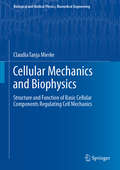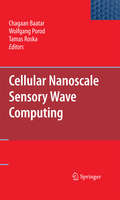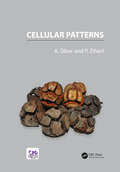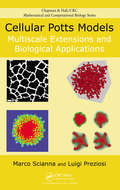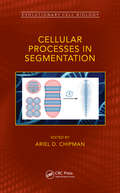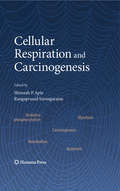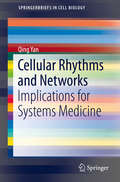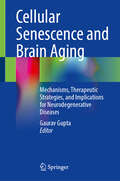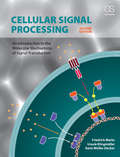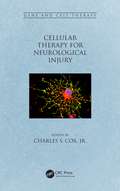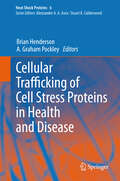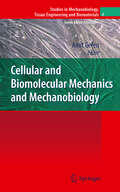- Table View
- List View
Cellular Mechanics and Biophysics: Structure and Function of Basic Cellular Components Regulating Cell Mechanics (Biological and Medical Physics, Biomedical Engineering)
by Claudia Tanja MierkeThis book focuses on the mechanical properties of cells, discussing the basic concepts and processes in the fields of immunology, biology, and biochemistry. It introduces and explains state-of-the-art biophysical methods and examines the role of mechanical properties in the cell/protein interaction with the connective tissue microenvironment. The book presents a unique perspective on cellular mechanics and biophysics by combining the mechanical, biological, physical, biochemical, medical, and immunological views, highlighting the importance of the mechanical properties of cells and biophysical measurement methods. The book guides readers through the complex and growing field of cellular mechanics and biophysics, connecting and discussing research findings from different fields such as biology, cell biology, immunology, physics, and medicine. Featuring suggestions for further reading throughout and addressing a wide selection of biophysical topics, this book is an indispensable guide for graduate and advanced undergraduate students in the fields of cellular mechanics and biophysics.
Cellular Mechanotransduction
by Mohammad R. K. Mofrad Roger D. Kamm"Mechanotransduction" is the term for the ability, first described by 19th-century anatomist Julius Wolff, of living tissues to sense mechanical stress and respond by tissue remodeling. More recently, the scope of mechanotransduction has been expanded to include the sensation of stress, its translation into a biochemical signal, and the sequence of biological responses it produces. This book looks at mechanotransduction in a more restricted sense, focusing on the process of stress sensing and transducing a mechanical force into a cascade of biochemical signals. This stress has become increasingly recognized as one of the primary and essential factors controlling biological functions, ultimately affecting the function of the cells, tissues, and organs. A primary goal of this broad book is also to help define the new field of mechanomics, which attempts to describe the complete mechanical state of a biological system.
Cellular Nanomachines: From Discovery to Structure-Function and Therapeutic Applications
by Bhanu P. JenaIn this book, the major paradigm-shifting discoveries made in the past century on key cellular nanomachines are described in great detail: their complex yet precise and elegant design and function, as well as the diseases linked to their dysfunction and the therapeutic approaches to overcome them. The major focus of this book is the “porosome” nanomachine, the universal secretory portal in cells. This is an ideal book for students, researchers, and professionals in the fields of nanoscience and nanotechnology.
Cellular Nanoscale Sensory Wave Computing
by Tamas Roska Wolfgang Porod Chagaan BaatarThis book is a result of a Multidisciplinary University Research Initiative (MURI) project that has been funded by the Office of Naval Research and completed recently. The results manifest a new way of thinking about sensory computing, as well as being one of the first successful attempts to bridge the gap between nanoscale (smaller than 100 nm) devices and CMOS integrated circuits with stored programmable algorithms and software on the system level. In this book the emerging and converging architecture of morphic cellular wave computers based on the concept of Cellular Neural/Nonlinear Network (CNN) is introduced in a practical way. The book also discusses the architecture and operation of a vision system on a chip (VSoC) which is in the first single chip cellular wave computer.
Cellular Osmolytes: From Chaperoning Protein Folding to Clinical Perspectives
by Laishram Rajendrakumar Singh Tanveer Ali Dar Kritika KumariThe second edition of this book presents the role of osmolytes in human health and diseases. Some of the chapters deal about the possibility of the use of osmolytes as diagnostic biomarkers and potential drug design for neurodegenerative and other human diseases. Other chapters also include reviews on the role of osmolytes in cancer, metastasis, infectious diseases, metabolic disorders, immunological disorders, and tissue regeneration. Importantly, the book also contain recent updates on the role of naturally occurring osmolytes in protein folding pathway, protein stability, and their underlying mechanisms. The book also covers the aspects that osmolytes could promote conformational alterations of transcription factors that favor metastatic behavior. Potential of the osmolytes in the various process of vaccine development, including enhancing the efficacy, production, and purification steps are also succintly described. Towards the end, the book also elucidates the use of specific molecules for the prevention of toxic gain of functions and restoration of function to disease-causing mutant protein. This book is an invaluable asset for the researchers especially working in osmolyte biology and scientists involved in basic and clinical research particularly neurodegeneration, diabetes, cancer, and metabolic disorders.
Cellular Osmolytes: From Chaperoning Protein Folding to Clinical Perspectives
by Laishram Rajendrakumar Singh Tanveer Ali DarThis book provides essential information on improving protein folding/stability, which is a result of the balance between the intra-molecular interactions of protein functional groups and their interactions with the solvent environment. The protein folding solvent environment mainly consists of salts, small molecule compounds, metabolites, molecular chaperones and other chemical species. Therefore, subtle change in the composition of the environment will alter the protein folding process. The importance of the solvent environment in protein folding is precisely due to the fact that various disease-causing proteopathies can be reversed by manipulating the solvent environment of the malfolded proteins. Hostile environmental stresses represent one of the basic causes of such challenges in protein folding or misfolding. Since cells commonly encounter extreme environmental fluctuations, it is crucial that they equip themselves with strategies to circumvent the hostile environmental conditions. Nature has developed many strategies to ensure that the complex and challenging protein folding reaction occurs with adequate efficiency and fidelity for the success of the organism. Among the strategies employed in a wide range of species and cell types is the elaboration of small organic molecules called osmolytes. Additionally, recent advances have also revealed that certain specific osmolytes might be key biomarkers of cancer, infectious diseases and vaccine flocculation. In fact, a large pool of data has been generated regarding their potential for the therapeutic intervention of neurodegenerative diseases and other metabolic disorders caused by protein aggregation or proteostasis failure. Reflecting the multiple applications of these small molecules in the health and other industries, this book combines contributions by respected leaders in the field and will help to inspire college students, basic researchers, and clinicians to translate these biological roles of osmolytes into clinical practice. It will also shed light on some important future prospects of osmolytes like their role as drug excipients and provide a deeper understanding of their mechanism of action in the prevention of neuro-degenerative diseases.
Cellular Patterns
by Antonio Siber Primoz ZiherlThe mechanics underlying the form and structure of biological tissues is being increasingly investigated and appreciated, with new results appearing at a fast pace. Cellular Patterns covers the salient elements of this thriving field of research in a textbook style, including both historic landmark results and recent achievements. <P><P>By building on concepts such as packing, confinement, surface tension, and elastic instabilities, the book explains the structure and the shape of sheet-like and bulk tissues by adapting the mechanics of continuous media to living matter. It reviews experimental results and empirical laws, and wherever possible, it discusses more than a single theoretical interpretation of a given phenomenon. <P><P>The in-depth treatment of technical details, the many boxes summarizing essential physical and biological ideas, and an extensive set of problems make this book suitable as a complementary textbook for a graduate course in biophysics and as a standalone reference for students and researchers in biophysics, bioengineering, and mathematical biology interested in the mechanics of tissue. <P><P>Features: <li>Provides an overview of patterns and shapes seen in animal tissues in addition to an interpretation of these structures in terms of physical forces and processes <li>Contains detailed analysis and a critical comparison of mechanical models of cells, tissues, and morphogenetic movements <li>Presents a visually rich style which is accessible to physicists and biologists alike
Cellular Peptide Hormone Synthesis and Secretory Pathways: Cellular Peptide Hormone Synthesis And Secretory Pathways (Results and Problems in Cell Differentiation #50)
by Jens F. Rehfeld Jens R. BundgaardThe purpose of the present volume is to illustrate the modern biological concept of basic endocrinology in one single book. It first describes general issues such as maturation of secretory granules in the cells, the roles of the chaperonic granins, and cell-specific prohormone processing. Subsequently, the specific part of the book illustrates the new endocrine biology, using as examples a broad variety of individual peptide systems: ACTH, Neurotensin and Neuromedines, Natriuretic Peptides, Glucagon and Glucagon-like peptides, Somatostatin, Ghrelin, Gastrin and VIP (Vasoactive Intestinal Polypeptide).
Cellular Potts Models: Multiscale Extensions and Biological Applications (Chapman & Hall/CRC Mathematical Biology Series)
by Luigi Preziosi Marco SciannaThis work shows how the cellular Potts model can be used as a framework for model building and how extended models can achieve even better biological practicality, accuracy, and predictive power. It focuses on ways to integrate and interface the basic cellular Potts model at the mesoscopic scale with approaches that accurately model microscopic dynamics. These extensions are designed to create a nested and hybrid environment, where the evolution of a biological system is realistically driven by the constant interplay and flux of information between the different levels of description.
Cellular Processes in Segmentation (Evolutionary Cell Biology)
by Ariel D. ChipmanThe evolution of segmentation is one of the central questions in evolutionary developmental biology. Indeed, it is one of the best case studies for the role of changes in development in the evolution of body plans. Segmented body plans are believed to have appeared several times in animal evolution, and to have contributed significantly to the evolutionary success of the taxa in which they are present. Because of the centrality of the subject, and the continuing interest in understanding segmentation, this book offers an often overlooked focus on the cellular aspects of the process of segmentation, providing an invaluable reference for students of evolutionary developmental biology at all levels. Key Features Explores the role that segmentation has played in the diversity of animals Documents the diverse cellular mechanisms by which segmentation develops Reviews the independent evolutionary origins of segmentation Provides insight into the general patterns of serial homology at the cellular level Related Titles Lynne Bianchi. Developmental Neurobiology (ISBN 978-0-8153-4482-7). Jonathan Bard. Principles of Evolution: Systems, Species, and the History of Life (ISBN 978-0-8153-4539-8). Gerhard Scholtz. Evolutionary Developmental Biology of Crustacea (ISBN 978-9-0580-9637-1). Dr. Ariel D. Chipman is Associate Professor in the Department of Ecology, Evolution & Behavior of the Silberman Institute of Life Sciences at The Hebrew University of Jerusalem. He is the author or co-author of dozens of peer reviewed scientific journal articles. His research focuses upon the evolution of animal body plans with a focus on arthropod segmentation, integrating comparative embryology, the fossil record and genome evolution.
Cellular Programming and Reprogramming: Methods and Protocols (Methods in Molecular Biology #636)
by Sheng DingBefore the therapeutic potential of cell replacement therapy or the development of therapeutic drugs for stimulating the body's own regenerative ability to repair cells damaged by disease and injury can be fully realized, control of stem cell fate, immuno-rejection, and limited cell sources must be overcome. In Cellular Programming and Reprogramming: Methods and Protocols, expert researchers cover the most recent technologies and their related mechanisms involved in the programming and reprogramming of cell fate. Written in the highly successful Methods in Molecular BiologyTM series format, chapters include introductions to their respective topics, lists of the necessary materials and reagents, step-by-step, laboratory protocols, and notes to highlight tips on troubleshooting and avoiding known pitfalls. Essential and cutting-edge, Cellular Programming and Reprogramming: Methods and Protocols promises to aid scientists attempting to advance stem cell biology in order to better treat devastating human diseases, including cardiovascular disease, neurodegenerative disease, musculoskeletal disease, diabetes, and cancer.
Cellular Respiration and Carcinogenesis
by Shireesh Apte Rangaprasad SarangarajanCellular Respiration and Carcinogenesis presents leading experts in the field as it informs the reader about both basic and recent research in the field of cellular respiration and the effects of its dysfunction, alteration or attenuation on the development of cancer. This masterfully compiled text offers the reader a fundamental understanding about how oxygen sensing and/or availability, programmed cell death, immune recognition and response and glucose metabolism are intimately linked with the two major mechanism or pathways of cellular respiration; oxidative phosphorylation and glycolysis. The editors and contributing authors proficiently and unequivocally address the effects of dysfunction of the mitochondrial oxidative phosphorylation/glycolysis (cellular respiration) mechanisms and pathways on the development of cancer. While it remains true that there are no universal truths in cancer, Cellular Respiration and Carcinogenesis opens the dialogue that the etiology of cancer can usually be associated with, and significantly attributed to the failure of one or multiple pathways of oxidative phosphorylation (cellular respiration) to normally burn fuel to generate energy, vis-à-vis the Warburg hypothesis. Keeping with its cutting-edge nature, Cellular Respiration and Carcinogenesis provides the first glimpse to a cautionary evidence based counterbalance to the recent and rapidly proliferating notion that utilization of fuel primarily via glycolysis is a hallmark of cancer development.
Cellular Rhythms and Networks: Implications for Systems Medicine (SpringerBriefs in Cell Biology)
by Qing YanThis book provides an overview of circadian rhythms and cellular networks in their relation to biological systems and dynamical medicine. Six concise chapters explore circadian cell rhythms and biomarkers in inflammation, cardiovascular disease, cancer, depression, and more in causing and treating these ailments. The final chapter discusses optimization of drug delivery and individualized treatment systems using chronotherapy and chronobiology-based biomarkers as a general system of medicine. Succinct yet comprehensive, Cellular Rhythms and Networks, part of SpringerBriefs in Cell Biology presents a novel framework for clinical applications in personalized and systems medicine. It is invaluable reading for researchers and clinicians in cell biology, mood disorders, and systems medicine.
Cellular Senescence and Brain Aging: Mechanisms, Therapeutic Strategies, and Implications for Neurodegenerative Diseases
by Gaurav GuptaThe book examines the cellular senescence in brain aging processes and its effects on three major neurodegenerative conditions: Alzheimer’s disease, Parkinson’s disease, and Huntington’s disease. It discusses basic aging mechanisms, including oxidative stress, mitochondrial dysfunction, and neuroinflammation, before moving on to current treatments such as senolytics and autophagy modulators. The book is divided into several chapters, with specific sections dedicated to experimental approaches, detection methods, and disease-by-disease analysis of cellular senescence effects. A specific chapter explores the clinical potential of senescence-targeting therapies and discusses upcoming study pathways. This publication is aimed at researchers in neuroscience, clinicians, graduate students, neuroscientists, and neuropharmacology professionals involved in the assessment of age-related disorders. It delivers thorough expertise by combining research evidence on brain aging with methods to combat cognitive decline. The structured system within this publication creates connections between basic research and medical implementation, providing essential knowledge for treating neurodegeneration.
Cellular Senescence, Age-Related Disorders, and Emerging Treatments
by Pawan Kumar Maurya Imteyaz QamarThis book provides a comprehensive understanding of cellular senescence, which is a phenomenon, characterized by the irreversible arrest of cell growth and is accompanied by the secretion of various factors, collectively known as the senescence-associated secretory phenotype (SASP), which can have detrimental effects on surrounding cells and tissues. The book examines the role of cellular senescence as a driver of age-related disorders such as cancer, neurodegenerative diseases, cardiovascular conditions, and metabolic disorders. By elucidating the molecular mechanisms involved, the book aims to deepen our understanding of these complex diseases and identify potential therapeutic targets. The book also explores cutting-edge therapeutic modalities that target cellular senescence, ranging from small molecule inhibitors to gene-based therapies and regenerative approaches. The distinctive features of the book include its comprehensive approach, integration of multidisciplinary expertise, in-depth exploration of therapeutic modalities, evidence-based insights supported by scientific research, and a translational focus. The interdisciplinary collaboration ensures a holistic understanding of the subject matter, fostering a synergistic approach to addressing age-related disorders. The book not only discusses the potential of emerging therapeutic modalities but also emphasizes practical implications, providing a bridge between research and real-world applications. This book is useful to researchers, scientists, and academics in the fields of molecular biology, genetics, gerontology, and cellular biology.
Cellular Senescence: Methods and Protocols (Methods in Molecular Biology #1896)
by Marco DemariaThis book describes current methods for the identification and characterization of the major hallmarks of senescent cells. Chapters focus on the high heterogeneity of the senescence phenotypes, and techniques to induce and identify specific senescence programs. Additional chapters describe cellular and mouse models in which is possible to study the complex cell and non-cell autonomous functions of senescent cells. Written in the highly successful Methods in Molecular Biology series format, chapters include introductions to their respective topics, lists of the necessary materials and reagents, step-by-step, readily reproducible laboratory protocols, and tips on troubleshooting and avoiding known pitfalls. Authoritative and cutting-edge, Cellular Senescence: Methods and Protocols aims to ensure successful results in the further study of this vital field.
Cellular Signal Processing: An Introduction to the Molecular Mechanisms of Signal Transduction
by Friedrich Marks Ursula Klingmüller Karin Müller-DeckerCellular Signal Processing offers a unifying view of cell signaling based on the concept that protein interactions act as sophisticated data processing networks that govern intracellular and extracellular communication. It is intended for use in signal transduction courses for undergraduate and graduate students working in biology, biochemistry, bioinformatics, and pharmacology, as well as medical students. The text is organized by three key topics central to signal transduction: the protein network, its energy supply, and its evolution. It covers all important aspects of cell signaling, ranging from prokaryotic signal transduction to neuronal signaling, and also highlights the clinical aspects of cell signaling in health and disease. This new edition includes expanded coverage of prokaryotes, as well as content on new developments in systems biology, epigenetics, redox signaling, and small, non-coding RNA signaling.
Cellular Signal Transduction in Toxicology and Pharmacology: Data Collection, Analysis, and Interpretation
by Jonathan W. Boyd Richard R. NeubigCovering a key topic due to growing research into the role of signaling mechanisms in toxicology, this book focuses on practical approaches for informatics, big data, and complex data sets. Combines fundamentals / basics with experimental applications that can help those involved in preclinical drug studies and translational research Includes detailed presentations of study methodology and data collection, analysis, and interpretation Discusses tools like experimental design, sample handling, analytical measurement techniques
Cellular Signaling in Health and Disease (Biological and Medical Physics, Biomedical Engineering)
by Martin BeckermanIn today's world, three great classes of non-infectious diseases - the metabolic syndromes (such as type 2 diabetes and atherosclerosis), the cancers, and the neurodegenerative disorders - have risen to the fore. These diseases, all associated with increasing age of an individual, have proven to be remarkably complex and difficult to treat. This is because, in large measure, when the cellular signaling pathways responsible for maintaining homeostasis and health of the body become dysregulated, they generate equally stable disease states. As a result the body may respond positively to a drug, but only for a while and then revert back to the disease state. Cellular Signaling in Health and Disease summarizes our current understanding of these regulatory networks in the healthy and diseased states, showing which molecular components might be prime targets for drug interventions. This is accomplished by presenting models that explain in mechanistic, molecular detail how a particular part of the cellular signaling web operates properly in health and improperly in disease. The stability of the health- and disease-associated states is dynamic and supported by multiple feedback loops acting positively and negatively along with linkages between pathways. During the past few years an ongoing series of important discoveries have been made that advance our understanding of how the body works and may guide us on how to better deal with these diseases. These include the discovery of chronic inflammation as a causal factor in all of these disease classes, the appearance of reactive oxygen species as a messenger molecule that can act both positively and negatively, the propensity of proteins to misfold into aggregation- and disease-prone forms, and the rise of epigenetics including the emergence of small non-coding RNA with important regulatory functions out of the so-called junk RNA. Chapters are devoted to each of these classes of findings with additional details integrated into the chapters dealing directly with the diseases. The connections responsible for maintaining stability are explored in depth.
Cellular Solids
by Lorna J. Gibson Michael F. AshbyIn this new edition of their classic work on Cellular Solids, the authors have brought the book completely up to date, including new work on processing of metallic and ceramic foams and on the mechanical, electrical and acoustic properties of cellular solids. Data for commercially available foams are presented on material property charts; two new case studies show how the charts are used for selection of foams in engineering design. Over 150 references appearing in the literature since the publication of the first edition are cited. The text summarises current understanding of the structure and mechanical behaviour of cellular materials, and the ways in which they can be exploited in engineering design. Cellular solids include engineering honeycombs and foams (which can now be made from polymers, metals, ceramics and composites) as well as natural materials, such as wood, cork and cancellous bone.
Cellular Therapies for Retinal Disease: A Strategic Approach
by Robert Lanza Steven D. Schwartz Aaron NagielThis book familiarizes the reader with the current landscape of cell-based therapies for the treatment of retinal disease, including diseases that affect the choriocapillaris, retinal pigment epithelium, photoreceptors, and retinal ganglion cells. Instead of utilizing a disease-centric approach to the topic, this book--edited by two world-renowned stem cell scientists--focuses on strategies for developing and transplanting the cells. This includes the creation of replacement cells, cell-based neuroprotection, and in vitro disease modeling and testing. The final chapters briefly review parallel approaches that do not directly utilize cellular transplantation. The use of cellular transplantation to treat retinal disease has recently become a viable and exciting therapeutic approach. The visibility of the retina and its laminar cellular architecture render it an ideal organ for the development of surgically delivered cellular therapies. Having an in-depth understanding of the current state of cell therapy for the eye is an essential first step toward utilizing similar approaches in other organs. Ophthalmologists, translational clinician-scientists, stem cell scientists, and researchers interested in eye disease will find Cellular Therapies for Retinal Disease: A Strategic Approach essential reading and it is also suitable for workshops or courses at the undergraduate or Ph. D. level.
Cellular Therapy for Neurological Injury (Gene and Cell Therapy)
by Charles S. Cox Jr.Cellular Therapy for Neurological Injury discusses the current status of cellular therapy for neurological disorders. The primary areas of focus include traumatic brain injury, stroke (ischemic and hemorrhagic), and spinal cord injury. The book explores cell therapy approaches to these and other conditions, while discussing current advances and a l
Cellular Therapy for Stroke and CNS Injuries (Springer Series in Translational Stroke Research)
by John H. Zhang Li-Ru ZhaoCellular therapy for stroke and neural trauma has gained worldwide attention during the last decade and has shown some promising results. Various cells, including neural stem cells, bone marrow stem cells, endothelial progenitor cells, and many others have had protective or regenerative effects in animal models. The proposed book will address recent research on all relevant cell types. In addition, it will provide information on cell isolation and culture skills, transplantation methods, and neurological functional evaluations. This is the first book to focus on cellular therapy for stroke and other CNS injuries.
Cellular Trafficking of Cell Stress Proteins in Health and Disease (Heat Shock Proteins #6)
by Brian Henderson A. Graham PockleySince the beginning of the 21st Century there has been a rapid increase in our understanding of the cellular trafficking mechanisms of molecular chaperones in eukaryotes and in prokaryotes. In the former, molecular chaperone trafficking can occur between the various cellular compartments, with concomitant movement of other proteins. Such events can also result in the release of molecular chaperones from cells. In bacteria, molecular chaperones are involved in the trafficking of other proteins and are themselves released into the external milieu. The increasing appreciation of the role of molecular chaperones and Protein-Folding Catalysts in the interplay between bacteria and the cells of their hosts is now an important area of research for understanding the mechanisms of infectious diseases. This volume brings together experts in the biochemistry, cellular biology, immunology and molecular biology of molecular chaperones and Protein-Folding Catalysts with a focus on the mechanisms of cellular trafficking of these proteins and the role of these variegated trafficking mechanisms in both human and animal health and disease.
Cellular and Biomolecular Mechanics and Mechanobiology (Studies in Mechanobiology, Tissue Engineering and Biomaterials #4)
by Amit GefenThis book describes these exciting new developments, and presents experimental and computational findings that altogether describe the frontier of knowledge in cellular and biomolecular mechanics, and the biological implications, in health and disease. The book is written for bioengineers with interest in cellular mechanics, for biophysicists, biochemists, medical researchers and all other professionals with interest in how cells produce and respond to mechanical loads.
